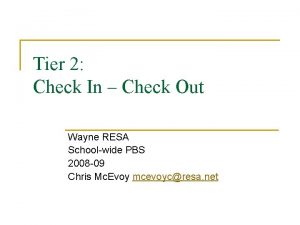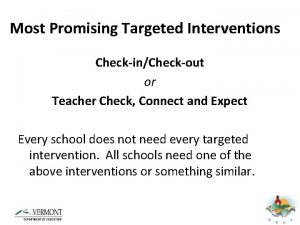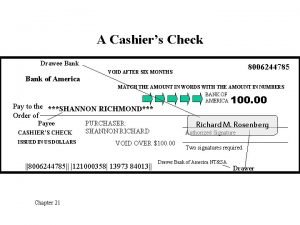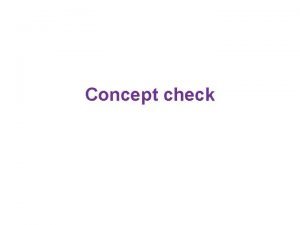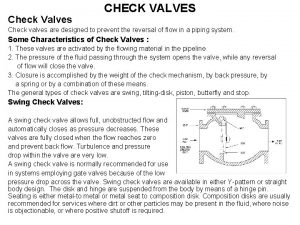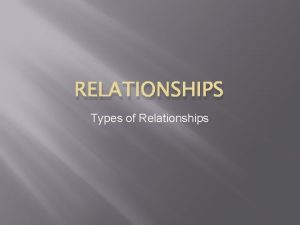Tool Check your relationships Tool Check your relationships






- Slides: 6

Tool: Check your relationships

Tool: Check your relationships Purpose and yield Your network and relationships are crucial to project success – if you have powerful relationships, you are a powerful project manager! • The tool uncovers and assesses the most important relationships in the project • Considers how strong the individual relationship is at the moment • Describes where the weak points in the individual relationship are • Defines which measures are necessary for improving the individual relationship When is the tool used in the project? • The tool can be used to evaluate the most important relationships at the start of the project. Are there relationships to be built? • The method can also be used continuously throughout the project when the project manager considers that there are challenges in the relationship with individual stakeholders. Pitfalls and restrictions • The descriptions on the template are the project manager's assessment and not the stakeholders' statements • The quality of the description depends on the project manager's knowledge of the relevant stakeholder • Descriptions can be improved by seeking feedback from stakeholders Relationships are built by trust. The stakeholders have to trust you. The equation below contains four properties that determine whether people trust you, and thus whether you can build up close relationships with others. Trust = Credibility + Reliability + Intimacy Focus on your own needs Source: ”The Trusted Advisor”, Maister, Green & Galford, 2002

Approach The four qualities that create trust Relations have to be built before you need them. It is absolutely crucial to make deposits into the goodwill account before you can withdraw backing and support. Credibility is based on your knowledge regarding the project task. You must have a professional standpoint. Did you put together a credible team to handle the task? Your credibility will be weakened if the stakeholders can see that your team is weak. What do you stand for? What are your values? Do you lead according to these standards and values? Do you announce honestly if you’re in doubt or simply don’t know the answer? Reliability. How do you fulfill your promises? Do you deliver on time? This is also very much about announcing changes instead of letting them pop up as a surprise. You should be ahead at all times and communicate adjustments coming up in the project. Reliability can also be affected by experiences from previous projects. Intimacy. It’s all about empathy and an honest interest in other people. This means that you have a personal relation which induces people to share their own personal worries. It describes your ability and readiness to be open and share your doubts and vulnerability. Less focus on your own needs. The last element describes how selfish you act. How much do your own interests come first compared with the stakeholder’s or the project’s interests? It’s all about how much your own interests are allowed to control or disturb your work. How to do This is primarily an analysis tool for the project manager. It will be an advantage if it is prepared on the basis of conversations and experiences with the stakeholders. Template 1: • Step 1: Enter the key stakeholders in the left column and mark with an X in the colored squares how much trust you think the stakeholder has in you. Green: Great confidence, you are perceived as a star. Yellow: Reasonable trust, but with some slips. Red: Lacks trust in you. • Step 2: Then consider the individual stakeholder from left to right in the four column. If there are problems with trust where is the challenge then? Mark with an X in the colored squares where you think the problem is. Green: No Problems, Yellow: Problematic, Red: Substantial problems. • Step 3: Then review the individual stakeholder from left to right and assess which initiatives you are going to use where you have set X in yellow or red. Complete your actions and follow up by asking stakeholders for feedback on your project leadership.

Template 1: Check your relationships Stakeholder Credibility Reliability Intimacy Focus on your own needs Mitigating measures Mitigating measures Mitigating measures Mitigating measures Mitigating measures Mitigating measures

References and links Connection to other tools • Risk analysis: The risk analysis can provide input on which important relationships you lack in your network or which relationships must be strengthened. • Plan: The plan describes what is to be delivered and when. It will give you a picture of who you get in contact with during the process and who is important for implementing critical things. How many resources should be used and who can support and allocate these resources? • Stakeholder analysis: The analysis describes: Who are the stakeholders? What is their position in relation to the project? Who has useful knowledge and who has the power to get things implemented? • Organization: The organization gives a picture of where the main stakeholders are located and their role in relation to the project. Links References • The book: The Trusted Advisor, 2001, Simon & Schuster Ltd. David H. Maister, Charles H. Green & Robert M.

Find other tools and other useful knowledge in theories, videos, books or through our e-learning modules Unleash your potential
